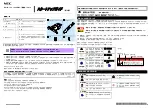
PmodPS/2™ Reference Manual
Copyright Digilent, Inc. All rights reserved.
Other product and company names mentioned may be trademarks of their respective owners.
Page 3 of 4
code (and they may send more than one scan code). When an extended key is released, an “E0 F0” key-up code is
sent, followed by the scan code. Scan codes for most keys are shown in the keyboard diagram below.
A host device can also send data to the keyboard. Below is a short list of some oft-used commands.
ED
Set Num Lock, Caps Lock, and Scroll Lock LEDs. After receiving an “ED”, the keyboard returns an “FA”, then
the host sends a byte to set LED status. Bit 0 sets Scroll Lock, bit 1 sets Num Lock; and Bit 2 sets Caps lock. Bits
3 to 7 are ignored.
EE Echo. Upon receiving an echo command, the keyboard replies with “EE”.
F3
Set scan code repeat rate. The keyboard acknowledges receipt of an “F3” by returning an “FA”, after which
the host sends a second byte
FE
Resend. Upon recieving FE, the keyboard re-sends the last scan code sent.
FF
Reset. Resets the keyboard.
Table 3. Common commands.
ESC
76
` ~
0E
TAB
0D
Caps Lock
58
Shift
12
Ctrl
14
1 !
16
2 @
1E
3 #
26
4 $
25
5 %
2E
Q
15
W
1D
E
24
R
2D
T
2C
A
1C
S
1B
D
23
F
2B
G
34
Z
1Z
X
22
C
21
V
2A
B
32
6 ^
36
7 &
3D
8 *
3E
9 (
46
0 )
45
- _
4E
= +
55
BackSpace
66
Y
35
U
3C
I
43
O
44
P
4D
[ {
54
] }
5B
\ |
5D
H
33
J
3B
K
42
L
4B
; :
4C
' "
52
Enter
5A
N
31
M
3A
, <
41
> .
49
/ ?
4A
Shift
59
Alt
11
Space
29
Alt
E0 11
Ctrl
E0 14
F1
05
F2
06
F3
04
F4
0C
F5
03
F6
0B
F7
83
F8
0A
F9
01
F10
09
F11
78
F12
07
E0 75
E0 74
E0 6B
E0 72
The keyboard sends data to the host only when both the data and clock lines are high (or idle). Since the host is the
“bus master”, the keyboard checks to see whether the host is sending data before driving the bus. To facilitate
this, the clock line can be used as a “clear to send” signal. If the host pulls the clock line low, the keyboard will not
send any data until the clock is released.
The keyboard sends data to the host in 11-bit words that contain a ‘0’ start bit, followed by 8-bits of scan code (LSB
first), followed by an odd parity bit and terminated with a ‘1’ stop bit. The keyboard generates 11 clock transitions
(at around 20 – 30kHz) when the data is sent, and data is valid on the falling edge of the clock.
3.2 Mouse
The mouse outputs a clock and data signal when it is moved, otherwise these signals remain at logic ‘1’. Each time
the mouse is moved, three 11-bit words are sent from the mouse to the host device. Each of the 11-bit words
contains a ‘0’ start bit, followed by 8 bits of data (LSB first), followed by an odd parity bit, and terminated with a ‘1’
stop bit. Thus, each data transmission contains 33 bits, where bits 0, 11, and 22 are ‘0’ start bits, and bits 11, 21,
and 33 are ‘1’ stop bits. The three 8-bit data fields contain movement data as shown below. Data is valid at the
falling edge of the clock, and the clock period is 20 to 30kHz.























